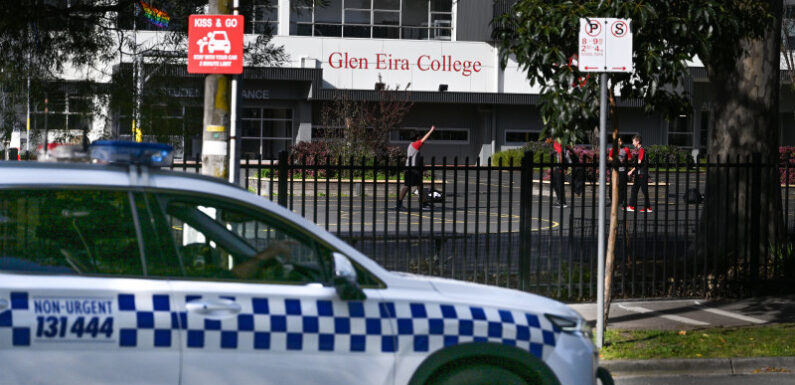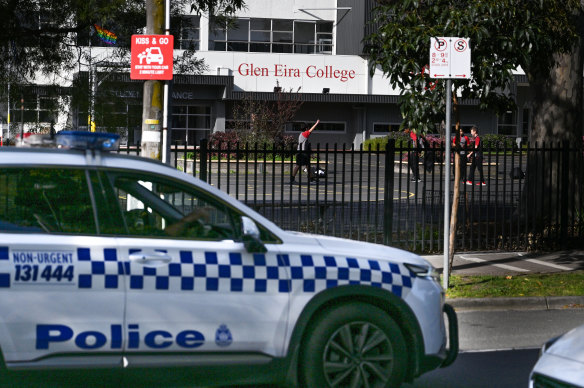
Save articles for later
Add articles to your saved list and come back to them any time.
When children leave for school in the morning, it’s a natural expectation that they return home at the end of the day safe and sound. That should be a given.
This week, however, another dreadful act of violence directed at a student walking home from school has not only shocked the community but, once again, called attention to a broader problem about threats to children’s safety.
Police patrol Glen Eira Secondary School this week.Credit: Joe Armao
In the latest incident, a 14-year-old Glen Eira College student was allegedly forced into an SUV in Glen Huntly, had items stolen, and was then ejected from the moving vehicle by his abductors. The teenager was taken to the Royal Children’s Hospital in a critical condition after sustaining injuries to his upper body. A 14-year-old boy who police believe is the principal offender in the abduction and armed robbery has been arrested and charged.
This is any parent’s nightmare scenario.
While this incident is unusual, and the vast majority of school children can safely go about their daily lives, the recent spate of attacks on students cannot be ignored.
Just a few weeks ago, Hawthorn independent boys school Scotch College and Glen Iris girls school Sacre Coeur sent letters to parents about violent attacks in Melbourne’s east and south-east, urging them to advise their children to stay alert to possible dangers. The letter was in reaction to two Scotch College students being held at knifepoint and robbed in separate incidents last month.
This week, parents with children enrolled in several schools again in the south-east of Melbourne were being advised by school administrators to take precautions around school pick-up and drop-off, after reports of students being targeted for goods, including phones, AirPods and laptops.
It’s not just while travelling to and from school that students can be targeted. According to information obtained through freedom of information from the Department of Education, in the 12 months from January 10, 2022, there were 78 reports of weapons in the state’s schools. In the past five years, the number of children aged 10 to 16 accused of committing serious assaults at public and private schools, school grounds and other educational areas has soared 45 per cent.
Youth workers and school support agencies who are engaged at the front line of this troubling trend say the data also reflects a rising wave of knife crime and an increase in the number of younger students carrying knives – either out of fear for their safety or because it has been glorified on social media.
The human repercussions of this trend can be devastating.
In March last year, a 16-year-old leaving a party in Reservoir in the early hours was stabbed to death after being ambushed by eight teenagers. In December, two teenage boys were charged over the fatal stabbing of a Tarneit teenager in St Kilda. Both matters remain before the courts.
And in May this year, a year 11 student hanging out with his schoolmates was stabbed near Sunshine train station when a fight involving what police say were groups from different schools broke out. He died at the scene. He was 16.
While highlighting the problem should raise concerns, the focus needs to be on finding an antidote.
Law enforcement certainly has a role to play. Patrolling known hotspots is a valuable deterrent. Methodically investigating and apprehending offenders can also send a strong message to others. But law and order measures can only go so far.
Particularly at school, teachers can play a valuable role. Giving teachers the training and resources to deal with such disruptive behaviour must be a high priority.
But groups such as Victoria’s Youth Support and Advocacy Service say the problem is too big and too nuanced for schools to deal with on their own.
This view is supported by experienced youth worker Hanad Hersi, who says no one strategy will be a silver bullet. He is calling for a multidisciplinary approach in which schools, police, youth workers, community organisations and local councils work together to address youth violence and crime to safeguard young people.
The state government must play a greater role co-ordinating such institutions that have the expertise to tackle the causes of this growing violence, and deliver a strategy for prevention as well as protection.
For all the heightened warnings, though, there must also be some perspective about the scale of the problem. Melbourne is a long way from the level of violence too often reported in American schools. Children here can still walk to school safely. While frightening, the recent violence and robberies are isolated incidents.
Students should take precautions and listen to what their schools are advising, but not let a few thugs dictate how they live.
Patrick Elligett sends an exclusive newsletter to subscribers each week. Sign up to receive his Note from the Editor.
Most Viewed in National
From our partners
Source: Read Full Article
